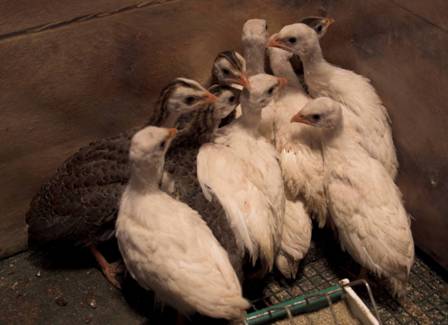|
The Bodilly Mill Hatching and brooding. Interested? So where do you start?
Well you can get your birds
from poultry sales and auctions fully grown.
When I
decided on becoming a †If you go down the 'partly grown' or 'fully grown' route sometimes called ‘off heat’ birds they will cost you anywhere between £5-£10 for a†6 week old standard mixed ‘Keet’ (young Guinea fowl chick).
You will pay more for birds that
have been raised and ‘hardened off’, that is… ‘off
heat’. (Not needing a heat lamp to
survive) this is because mortality rates can be unpredictable sometimes.
For special strains of the breed I have seen £100 paid.†Vulturine strains are very pretty and ornamental but need winter heat in this country so they need special care.
Grown standard birds you might certainly budget £10
for. these are 2 weeks old Keets
Incubating If your doing it they way I did?
Things you need to know and do because I have already learnt this. Buy a Hygrometer (about £20) it
will tell you the temperature and the humidity in the Incubator and then in
the brooder after, maintaining these two things is very important. Incubators.
Buy an automatic!!!!! Its
easier…honest Temperature As I stated the temperature should
be set around 37.5 degrees Celsius anything hotter or colder can affect
embryo development. I have heard that you can apparently alter the temperature and by maintaining
slightly under or over,
alter the chances of the development of male or female Keets (baby guineas).
Since I do not do this commercially I have never gone into to this
extent but I have heard you can. Humidity Keep humidity to about 60% for the
first 25 days in the incubator by adding water to the internal trays* or bowl**
(see above mistake made though when I put a bowl into the brooder*
* Some incubators come with internal trays of the right size already calibrated when filled with water to give you the right humidity at the right temperature. **An open tall dish (it has to have
a good surface area). It also must be high enough so that if a
‘Keet’ hatches early it doesn’t go for a premature swim (it’ll
either drown or catch hypothermia, either situation not good). You can always
use a breakfast bowl in a manual incubator with chicken wire fixed over the
top to prevent accidental Tom Daley behaviour. Hatching Mother nature can be a cruel
mistress. At 25 days you can hear your little Keets cheeping away and when
they ‘pip’ (start coming out) the tendency to help is Oh so, so,
tempting….Don’t do it!...†
get the humidity up to about 90% (add another bowl or fill the other
recommended tray with water). If all goes well what happens is the
‘Keet’ turns inside the egg in the moist shells environment. As
more air get’s into the egg the membrane starts to get drier (not dry)
and separates from the ‘Keets’ feathers or skin. The membrane has
a blood supply attached to the ‘Keet’ like the placenta in a
human. Removing it too quickly can cause blood loss and or infection in the
‘Keet’. Don’t do it. Yes you may loose some naturally but
you will loose more if you try to help nature.† Leave ‘Keets’ in the Incubator
until they fluff up and are dry in the heat of the incubator before handling
or moving to the Brooder. |
||||
|
† |
